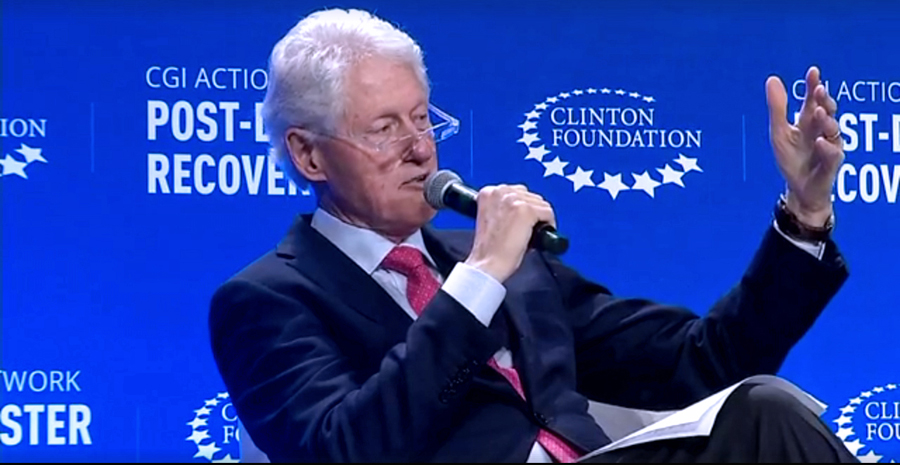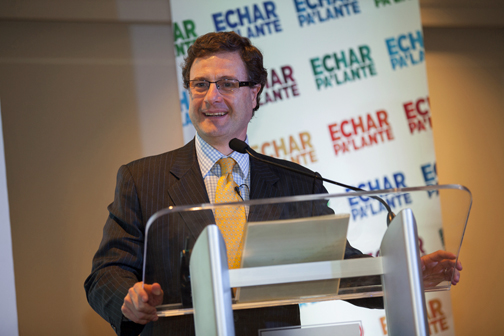Clinton: ‘Puerto Rico could lead Caribbean in move toward energy independence’


President Bill Clinton said Puerto Rico should strategize, along with its Caribbean neighbors, on freeing itself from its deep reliance on oil to generate power. (Credit: © Mauricio Pascual)
Former U.S. President Bill Clinton, who visited Puerto Rico this week to discuss his views on furthering renewable energy use, told a roomful of government officials, academics, lawmakers and business leaders Tuesday that the U.S. territory has the tools to “lead the entire Caribbean in a move toward being energy-independent.”
Saying that several islands in the Caribbean boast some of the highest electricity rates per hour — from 56 cents per kilowatt-hour in the U.S. Virgin Islands to between 35 cents and 40 cents per KwH in the Dominican Republic and Haiti — the former commander-in-chief noted such high rates are “bad for the environment and debilitating for the economy.”
“You have a chance to set an example for the world in having an energy policy that allows economic growth and environmental responsibility,” he said during a speech delivered at the Conservatory of Music in Miramar. “You have the possibility to take away the number one impediment to future economic growth, which is high energy costs.”
Mentioning a number of renewable energy projects already operating on the island, Clinton said Puerto Rico should strategize, along with its Caribbean neighbors, on freeing itself from its deep reliance on oil to generate power.
In doing so, the island would succeed in lowering its energy costs, which he called a “severe constraint on growth.”
“Whenever an economy has a cost that is glaringly out of line with its competitors, it’s a severe constraint on growth,” he said. “If I were planning Puerto Rico’s economic future and wanted to keep the unemployment rate down and stop outmigration of Puerto Ricans and encourage them to come home, I would ask myself, ‘what can I do to increase the economic growth rate here in a way that generates more good jobs? The most obvious answer is to cut the cost of energy.”
Puerto Rico depends on the use of petroleum — an environmentally unfriendly and expensive source — to generate about 70 percent of its electricity. Diversifying into wind and solar power sources could potentially alleviate both issues, he said.
“[Imported oil] is heavy, very much polluting, and wildly expensive,” he said. “It’s bad for the environment and debilitating for the economy.”

Clinton and Gov. García-Padilla share a lighthearted moment toward the end of the presentation Tuesday. (Credit: © Mauricio Pascual)
García-Padilla pledges action
Gov. Alejandro García-Padilla, who hosted Clinton’s visit, spoke briefly Tuesday, acknowledging the challenges associated with building a sustainable energy infrastructure, but stressed “energetic autonomy is possible.”
“The goal continues to be to reduce Puerto Rico’s dependency on petroleum to generate energy from 69 percent to 40 percent in five years,” he said. “Converting the Puerto Rico Electric Power Authority’s southern plants to natural gas is now a priority.”
The administration’s plans are to produce 50 percent of Puerto Rico’s energy based on natural gas by 2015, and 70 percent by 2017, he said.
Furthermore, he confirmed that in the last two weeks, the administration had granted permits to build systems to generate 100 megawatts of solar energy, 60 megawatts of which had been approved Tuesday.
Moving those types of renewable energy projects forward has been a challenge in recent months, as industry sources have said that PREPA has halted about 60 projects approved by the Luis Fortuño administration.
Clinton, who said to be familiar with the island’s power generating industry — particularly PREPA’s situation — said whatever steps are taken must consider the agency’s debt.
“I know there are problems here, nothing should be done to impair the utility’s ability to pay its bonds. But if you cut the base level cost of energy and keep the profit margins necessary to pay bonds obligations, you will still be ahead,” he said.

Clinton (right) responds during a question and answer session with Sergio Marxuach (left) and Carmen Guerrero (center). (Credit: © Mauricio Pascual)
Building a rooftop solar panel grid
During a question and answer session with panelists Carmen Guerrero, Secretary of the Department of Natural and Environmental Resources and Economist Sergio Marxuach, public policy director of the Center for a New Economy, Clinton agreed with the idea of using rooftops to install solar power systems to address Puerto Rico’s energy needs.
A University of Puerto Rico study confirmed that the island has enough flat roofs available to meet all of its energy demands through solar panels, Guerrero said.
“It would be quicker, easier and cause less turmoil if the utility [PREPA] itself owned the solar panels, but everybody had a right to put them up in their building and generate power for themselves as well as to give back to the company,” he said.
Furthermore, he said blanketing the island with solar panel systems could represent an economic boost, “because you’ll need so many of them, you can get some of these companies to come down and make them here.”
“If you became the first place in the Caribbean to do this, you could also become a manufacturing center and supply most of region with solar panel pieces,” said Clinton. “Suppose you decide to do this rooftop initiative, the first thing you should do is have the university that conducted the study establish a partnership with a stateside university and attract serious investments to establish a world-class research center here on all of these emerging solar technologies.”











Hint: p-u-b-l-i-c—p-r-i-v-a-t-e—p-a-r-t-n-e-r-s-h-i-p !!!
An infusion….not just one or two.